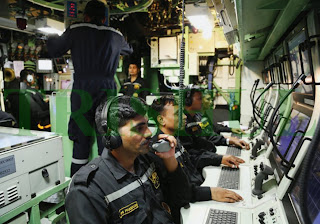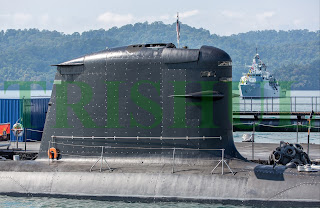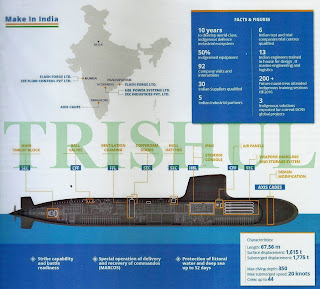
New-generation mobile, high-energy solid-state
laser-based directed-energy weapons (DEW) are fast emerging as cost-effective
counter-rocket, counter-artillery, counter-PGM, counter-UAV and counter-mortar
systems, since a laser destroys targets with pinpoint precision within seconds
of acquisition, then acquires the next target and keeps firing. Such DEWs will thus augment existing kinetic strike weapons like
surface-to-air missiles and offer significant reductions in cost per
engagement. With only the cost of diesel fuel, a HEL-based DEW system can fire
repeatedly without expending valuable munitions or additional manpower. Target
destruction is achieved by projecting a highly focused, high-power solid-state
chemical laser beam, with enough energy to affect the target, and explode it in
midair. This operational concept is thus for the very first time offering the
first ‘reusable’ interception element. Existing interceptors use kinetic energy
kill vehicles (such as blast-fragmentation warheads), which are not reusable.

A major advantage of HEL effectors is
their outstanding flexibility with regard to escalation and de-escalation.
Laser beams are eminently scaleable. When fired at optics, radio antennas,
radars, ammunition or energy sources, for example, HEL effectors are able to
neutralise entire weapons systems without destroying them. At ranges of 2km,
mobile HEL effectors in the 50kW laser class clearly demonstrated their ability
to locate, track and destroy optics such as riflescopes and remotely operated
cameras. HEL effectors have also been used to quickly cut the power-supply
cable of a radar mast and then the mast itself. Laser engagement of an ammo box
followed by swift deflagration of its explosive content has also been
accomplished. When integrated with a vehicle-mounted active phased-array radar
for target acquisition/tracking, such HEL effectors can provide air-defence
against UAVs of all types, as well as mortar rounds, PGMs and even manned
combat aircraft.

The idea that combat aircraft can use solid-state laser-based DEW systems defensively, creating a sanitised sphere of safety around the aircraft, shooting down or critically damaging incoming guided-missiles
and approaching aircraft with their laser turrets, is also fast becoming a
reality. Fifth-/sixth-generation multi-role combat aircraft will also use such
a system offensively, leveraging their stealth capabilities to sneak up on
enemy aircraft and striking with speed-of-light accuracy. The
introduction of nimble and compact lasers on the aerial battlefield will likely
allow combat aircraft designs to cease putting a premium on manoeuvrability, as
lasers are speed-of-light weapons. In other words, as long as the enemy can be
detected and is within the laser’s range, they are at risk of being fried
regardless of how hard they try to evade via hard turns and other high-g manoeuvres.

Countermeasures will become more about evading initial detection, staying
outside an opposing aircraft’s laser’s envelope, and confusing targetting
sensors than out-manoeuvring the adversary. In other words, the dogfights of
the future will look nothing like they do today. One issue pointed out by
Northrop Grumman is that these lasers, along with future engines and avionics,
will put out a huge amount of heat, making thermal control a huge concern for
stealthy aircraft, IR search-n-track sensors--both air- and ground-based--are only becoming
more sensitive and reliable as time goes on. As a result, future stealthy
combat aircraft will have to keep their cool in order to remain undetected over
the battlefield.

One way aerospace OEMs
like Northrop Grumman are looking at dealing with this problem will be by using
a large thermal accumulator to control the aircraft’s heat signature while
using laser weaponry, although Northrop Grumman seems to be pursuing a
different—albeit more shadowy—way of dealing with the problem. Venting the heat
off-board only raises the aircraft’s visibility to heat-sealing sensors.
Another option is to develop a thermal accumulator, which is a path the USAF is
pursuing. An electrical accumulator stores the energy on-board in the same way
as a hydraulic accumulator, releasing the latent energy as necessary to
generate a surge of power. But Northrop Grumman’s sixth-generation multi-role
combat aircraft concept, for instance, eschews the accumulator concept for
thermal management because such a system imposes a limitation on the laser
weapon’s magazine size or firing rate, forcing the pilot to exit combat until
the accumulator is refilled with energy. Northrop Grumman is therefore pursuing
a concept that does not rely on accumulators or off-board venting to manage the
heat.

Fibre-lasers are typically around 25%
efficient at converting DC current to light. Thus a 50kW, two-minute
blast would require over 6kW-hours of juice—or roughly 10 car batteries worth
of power (car batteries have typically around 1.2kW-hour theoretical capacity
and are 50% efficient in the real world). However, fibre-lasers are bulky
so may not be mountable on vehicles. Therefore, chemical solid-state lasers, are
a more likely possibility, but are expensive on a per-shot basis. The biggest
problem will likely be the cooling. For instance, the US Navy’s existing
seaborne 15kW HEL effectors already need heavy advanced cooling systems.
That will suck down yet more power, while increasing the system size and
weight. The US Navy’s projected 30kW solid-state laser weapon system (LaWS)
requires the laser to be able to have several different power settings: from a
so-called dazzle effect to confuse sensors to a lethal ability that would be
able to splash an UAV or an inbound anti-ship cruise missile, or to disable a
small boat.

On land, the US Navy wants its HEL-based DEW to weigh less
than 2,500 lb and achieve a minimum 25kW beam strength, capable of shooting
down UAVs. The long-term goal is to sustain a 50kW blast for two minutes
with optronics capable of adjusting to environmental conditions like humidity
and smoke/haze. The beam is also expected to have a fast turn-around
time--a 20-minute recharge to 80% of total capacity (power and thermal).

Boeing has developed a 10kW HEL-based DEW that weighs 650 lb and will be operated
by a squad of eight to 12 soldiers. Able
to be assembled in just 15 minutes, this DEW is capable of generating an energy
beam to acquire, track, and identify a target—or even destroy it—at ranges of
at least 22 miles. Within five years the energy density of this weapon’s
batteries could be doubled and the other components should also be further
reduced in size to get the weight down to 200 lb. Both Boeing and Raytheon,
along with RAFAEL of Israel, are now developing 300kW HEL effectors could fit
into 15-tonne trucks. Similarly, Germany’s Rheinmetall, through its 30kW
Skyshield air-defence HEL effector, has demonstrated
the ability to combine several laser beams on a single target, which develops
sufficient power to destroy UAVs, PGMs and cruise missiles.

China’s Jiuyuan Hi-Tech
Equipment Corp, a firm under the China Academy of Engineering Physics (CAEP), claimed on November 3, 2014 that it has developed a land-mobile
HEL-based DEW that can shoot down small aircraft and UAVs out to a distance of
2km within seconds. It is reportedly effective against
aircraft flying at up to 50 metres per second up to a maximum altitude of 500
metres. The definitive Sentinel system can locate small aircraft within a
1.2-mile radius and shoot down small drones flying under 110mph and below 1,600
feet.

Another China-based
company—GuoRong Technology—recently conducted technical trials of its truck-mounted
DEW that can destroy airborne drones. The
company claims that its DEW the laser successfully fired at least twice,
including one on a plate of aluminum a few millimetres thick at a distance of
360 metres. In less than 10 seconds, the aluminum plate was pierced with a
hole about 4 centimetres in diameter, and the drone, with its control unit destroyed,
finally crashed to the ground.

India’s defence R &
D Organisation (DRDO) too has been involved with the development of HEL-based
DEW since 2008, with all R & D work being conducted at the High Energy
Laser Integration Facility in the campus of the Hyderabad-based Centre for High
Energy Systems and Sciences (CHESS). The CHESS is mandated by DRDO to be the nodal
centre for the design and development of DEWs. Another DRDO-owned laboratory,
the Laser Science and Technology Centre (LASTEC) is working on the development
of laser source technologies for DEWs, and has so far developed core
technologies, including gas dynamic high-power laser (GDL) and chemical oxygen
iodine lasers (COIL), and has thus far demonstrated 100kW (multi-mode) GDL and
20kW (single-mode) COIL sources. LASTEC has also developed 1kW fibre-laser
through collaboration.

Presently, R & D on 5kW and 9kW fibre-laser sources
utilizing complex beam-combining technologies is underway. Power output from
these sources will be combined in space for various tactical applications.
LASTEC has also initiated work on the development of pulsed fibre-lasers for
different military applications. To this end, the laboratory’s ADITYA project
was an experimental testbed to seed the critical DEW technologies.

























































